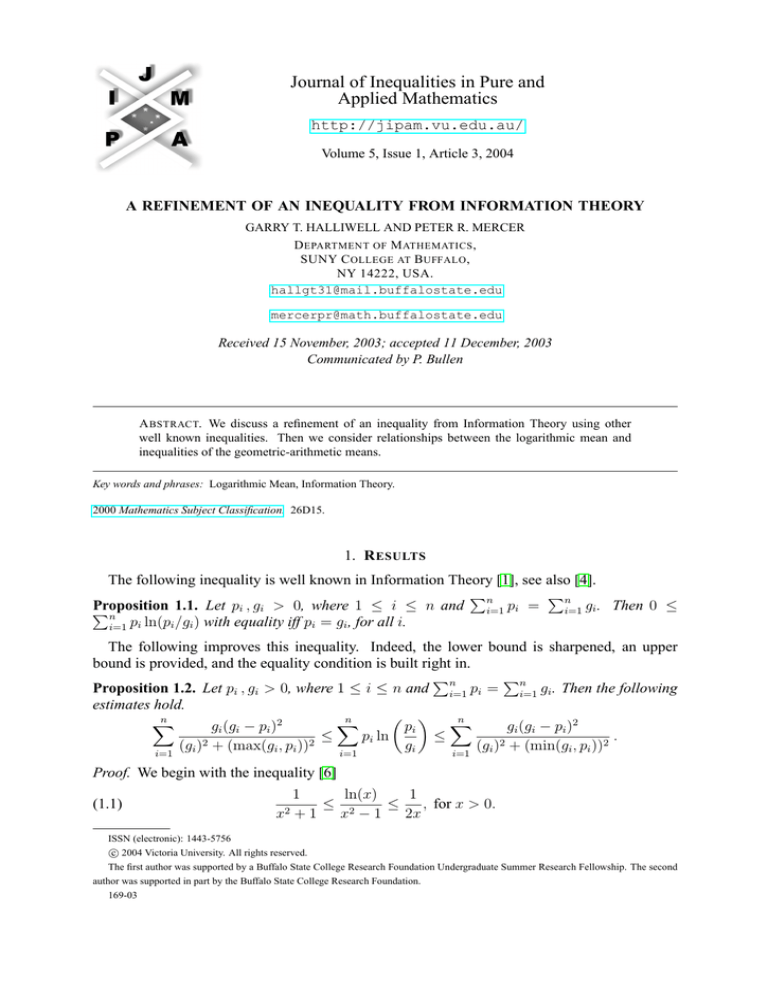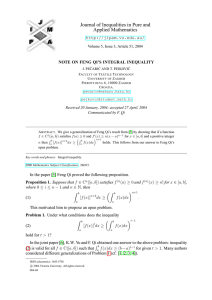
Journal of Inequalities in Pure and
Applied Mathematics
http://jipam.vu.edu.au/
Volume 5, Issue 1, Article 3, 2004
A REFINEMENT OF AN INEQUALITY FROM INFORMATION THEORY
GARRY T. HALLIWELL AND PETER R. MERCER
D EPARTMENT OF M ATHEMATICS ,
SUNY C OLLEGE AT B UFFALO ,
NY 14222, USA.
hallgt31@mail.buffalostate.edu
mercerpr@math.buffalostate.edu
Received 15 November, 2003; accepted 11 December, 2003
Communicated by P. Bullen
A BSTRACT. We discuss a refinement of an inequality from Information Theory using other
well known inequalities. Then we consider relationships between the logarithmic mean and
inequalities of the geometric-arithmetic means.
Key words and phrases: Logarithmic Mean, Information Theory.
2000 Mathematics Subject Classification. 26D15.
1. R ESULTS
The following inequality is well known in Information Theory [1], see also [4].
Pn
Pn
Proposition
1.1.
Let
p
,
g
>
0,
where
1
≤
i
≤
n
and
p
=
i
i
i
i=1
i=1 gi . Then 0 ≤
Pn
p
ln(p
/g
)
with
equality
iff
p
=
g
,
for
all
i.
i i
i
i
i=1 i
The following improves this inequality. Indeed, the lower bound is sharpened, an upper
bound is provided, and the equality condition is built right in.
P
P
Proposition 1.2. Let pi , gi > 0, where 1 ≤ i ≤ n and ni=1 pi = ni=1 gi . Then the following
estimates hold.
X
n
n
n
X
X
pi
gi (gi − pi )2
gi (gi − pi )2
≤
p
ln
≤
.
i
2 + (max(g , p ))2
2 + (min(g , p ))2
(g
)
g
(g
)
i
i
i
i
i
i
i
i=1
i=1
i=1
Proof. We begin with the inequality [6]
(1.1)
x2
1
ln(x)
1
≤ 2
≤
, for x > 0.
+1
x −1
2x
ISSN (electronic): 1443-5756
c 2004 Victoria University. All rights reserved.
The first author was supported by a Buffalo State College Research Foundation Undergraduate Summer Research Fellowship. The second
author was supported in part by the Buffalo State College Research Foundation.
169-03
2
G ARRY T. H ALLIWELL AND P ETER R. M ERCER
Thus
x2 − 1
x2 − 1
≤ ln(x) ≤ 2
2x
x +1
for 0 < x ≤ 1 ,
and
x2 − 1
x2 − 1
≤
ln(x)
≤
x2 + 1
2x
Equalities occur only for x = 1. We rewrite these as
x−1−
(1.2)
for 1 < x .
(x − 1)2
x(x − 1)2
≤ ln(x) ≤ x − 1 −
2x
x2 + 1
for 0 < x ≤ 1 ,
and
x(x − 1)2
(x − 1)2
≤
ln(x)
≤
x
−
1
−
for 1 < x .
x2 + 1
2x
Now, substituting gi /pi for x in (1.2) and (1.3), and then summing we obtain
X
X
X gi (gi − pi )2
X
gi
gi −
pi −
≤
p
ln
i
(gi )2 + (gi )2 g ≤p
pi
g ≤p
g ≤p
g ≤p
x−1−
(1.3)
i
i
i
i
i
i
i
≤
i
X
gi −
gi ≤pi
X
pi −
gi ≤pi
X gi (gi − pi )2
(gi )2 + (pi )2
g ≤p
i
i
and
X
gi >pi
gi −
X
gi >pi
X gi (gi − pi )2
X
gi
pi −
≤
pi ln
2
2
(gi ) + (pi )
pi
g >p
g >p
i
i
i
≤
i
X
gi −
gi >pi
X
gi >pi
pi −
X gi (gi − pi )2
(gi )2 + (gi )2
g >p
i
i
respectively.
P
P
Taking these together and using ni=1 pi = ni=1 gi we have our proposition.
2. R EMARKS
√
Remark 2.1. With G = xy, L = (x − y)/(ln(x) − ln(y)), and A = (x + y)/2, being
the Geometric, Logarithmic, and Arithmetic Means of x, y > 0 respectively, the inequality
G ≤ L ≤ A is well known [8], [2]. This can be proved by observing (c.f. [5]) that
Z 1
L=
xt y 1−t dt,
0
and then applying the following:
Theorem 2.2 (Hadamard’s Inequality). If f is a convex function on [a, b], then
Z b
a+b
f (a) + f (b)
(b − a)f
≤
f (t) dt ≤
(b − a)
2
2
a
with the inequalities being strict when f is not constant.
The inequality in (1.1) now can be obtained by letting y = 1/x in G ≤ L ≤ A. Thus any
refinement of G ≤ L ≤ A would lead to an improved version of (1.1) and, in principle, to
2
1
an improvenemt of Proposition 1.2. For example, it is also known that G ≤ G 3 A 3 ≤ L ≤
2
G + 13 A ≤ A [3], [8], [2]. The latter can be proved simply by observing that the left side of
3
Hadamard’s Inequality is the midpoint approximation M to L and the right side is the trapezoid
J. Inequal. Pure and Appl. Math., 5(1) Art. 3, 2004
http://jipam.vu.edu.au/
A R EFINEMENT OF AN I NEQUALITY
FROM I NFORMATION
T HEORY
3
approximation T . Now 32 M + 13 T is Simpson’s rule and looking at the error term there (e.g.
[7]) yields L ≤ 32 G + 13 A ≤ A.
2
1
Remark 2.3. Using G ≤ G 3 A 3 ≤ L ≤ 23 G + 13 A ≤ A, with y = x + 1 we get
1
p
p
2
2x + 1 3
x(x + 1) ≤ ( x(x + 1)) 3
2
1
2p
1 2x + 1
2x + 1
≤
x(x + 1) +
≤
.
1 ≤
3
3 2
2
ln(1 + x )
Therefore
1/3
2 √x(x+1)+ 13 2x+1
(√x(x+1))2/3 ( 2x+1
2
2 )
1 3
1
1+
<e< 1+
x
x
(c.f. [4]). For example x = 100 gives 2.71828182842204 < e < 2.71828182846830. Now
e = 2.71828182845905 . . . , so the left and right hand sides are both correct to 10 decimal
places. We point out also that x does not need to be an integer.
2
1
Remark 2.4. Using G ≤ G 3 A 3 ≤ L ≤ 23 G + 13 A ≤ A, and replacing x with ex and letting
y = e−x , we have
sinh(x)
2 1
≤ + cosh(x) ≤ cosh(x).
1 ≤ (cosh(x))1/3 ≤
x
3 3
ACKNOWLEDGEMENT
The authors are grateful to Daniel W. Cunningham for helpful suggestions and encouragement. The authors are also grateful to the referee and editor for excellent suggestions.
R EFERENCES
[1] L. BRILLOUIN, Science and Information Theory, 2nd Ed. Academic Press, 1962.
[2] B.C. CARLSON, The logarithmic mean, Amer. Math. Monthly, 79 (1972), 72–75.
[3] E.B. LEACH AND M.C. SHOLANDER, Extended mean values II, J. Math. Anal. Applics., 92
(1983), 207–223.
[4] D.S. MITRINOVIĆ, Analytic Inequalities, Springer-Verlag, Berlin, 1970.
[5] E. NEUMAN, The weighted logarithmic mean, J. Math. Anal. Applics., 188 (1994), 885–900.
[6] P.S. BULLEN, Handbook of Means and Their Inequalities, Kluwer Academic Publishers, 2003.
[7] P.S. BULLEN, Error estimates for some elementary quadrature rules, Elek. Fak. Univ. Beograd.,
577-599 (1979), 3–10.
[8] G. PÒLYA
Pr., 2001.
AND
G. SZEGÖ, Isoperimetric Inequalities in Mathematical Physics, Princeton Univ.
J. Inequal. Pure and Appl. Math., 5(1) Art. 3, 2004
http://jipam.vu.edu.au/











